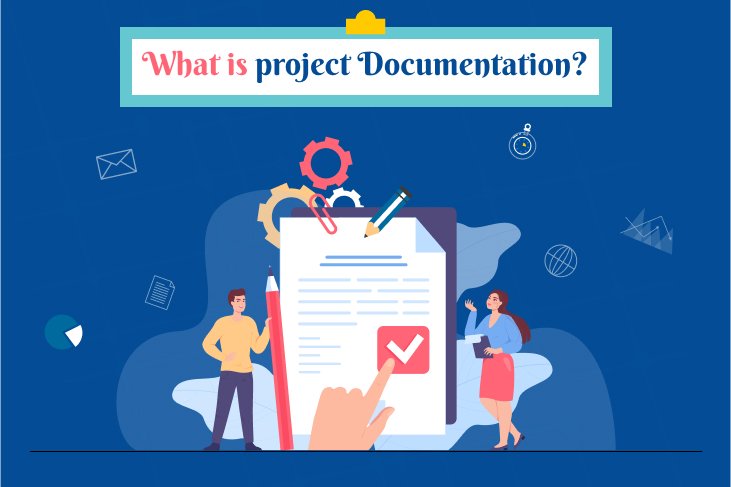What is project documentation?

A project’s documentation is a set of records and information that includes details about the project. In every phase of project management, a project manager typically gathers all pertinent work, including docs pertaining to proposals, objectives, specifications, layout, execution, financial management, testing, delivery, and maintenance.
Project managers can better monitor progress, maintain organization, and assure compliance with documentation. The project’s documentation makes the task at hand go more smoothly. You won’t have to waste time looking for paperwork or impede your team’s progress when you need to consult budgets or respond to requests from stakeholders for project proposals or designs.
What are the types of project documentation?
There are various types of project documentation such as graphs, diagrams, policies, project plans, reports, etc. Below are the commonly followed documentation with examples.
Project Charter
A project charter is an official document that gives permission and lays the groundwork for a project. The document defines the goals, extent, interested parties, outputs, limitations, presumptions, and high-level schedule of the project. Throughout the project lifecycle, the project team and stakeholders are guided by the project charter, which acts as a point of reference for the start of the project.
What should be included in project documentation?
To create project charter documentation:
- Clearly state the name of the project and provide a brief overview of its purpose and objectives.
- Define the specific goals, outcomes, and project aims to achieve.
- Identify the individuals, groups, or organizations that have an interest or influence in the project.
- Lists the products, services, or results that the project will produce or deliver.
- Provide an overview of the project’s timeline, including major milestones, deadlines, and key phases or stages.
- Include signatures or approval from key stakeholders indicating their commitment and support for the project.
Project Plan
A project plan, often referred to as a scope of work (SOW), is a detailed document that lists all of the steps, materials, methods, schedules, and deliverables needed to finish a project effectively. It gives a thorough summary of the project’s goals, objectives, and execution plan and acts as a roadmap for carrying it out.
The main elements that are usually included in a project plan or scope of work are broken down as follows:
- Project Approach: Outlines the methodology, strategies, and techniques that will be used to execute the project.
- Project Deliverables: Deliverables are clearly defined, measurable, and aligned with project objectives to ensure that they meet stakeholders’ requirements and expectations.
- Work Breakdown Structure: Break down the project scope into smaller, manageable tasks or activities.
- Risk Management Plan: It includes risk assessment, risk response planning, and contingency planning to minimize negative impacts on project outcomes.
- Communication Plan: Defines the channels, frequency, and stakeholders for project communication.
- Change Management Plan: Describes the process for managing changes to project scope, requirements, schedule, and budget.
Project change management plan
A project’s scope, requirements, timeline, and budget can all be changed. The steps involved in doing so are described in a project change management plan. It guarantees that, in order to reduce disturbances and preserve project success, modifications are assessed, recorded, authorized, and executed in a regulated way.
Project status report
A project status report is an extensive project documentation that gives a summary of a project’s performance, progress, and present state. It acts as a communication tool to keep all parties involved up to date on the project’s accomplishments, difficulties, dangers, and future plans. State schedule, blocked, postponed, dangerous, aborted, or important project choices, actions, tasks, or modifications since the last status report in few words.
How do you organize project documentation?
- Choose a centralized location or platform to store all the documentation.
- Develop a logical folder structure to categorize and organize different types of documentation.
- Adopt consistent naming conventions for files and folders to ensure clarity and consistency.
- Organize documentation according to the project lifecycle phases, such as initiation, planning, execution, monitoring, and closure.
- Implement version control mechanisms to track changes and revisions to documentation.
- Assign appropriate access permissions to documentation based on role and responsibility.
- Establish processes for regularly updating and reviewing project documentation to ensure accuracy, relevance, and completeness.
Conclusion
In short, project documentation is essential to making sure a project is successful. It keeps everything organized, promotes effective communication, and guarantees that project specifications are met.
Project managers may successfully monitor progress and solve difficulties as they emerge by recording essential information, including project objectives, plans, modifications, and status. Teams may minimize risks, expedite project execution, and accomplish project objectives more effectively with a complete and well-organized collection of project documentation.

